Earth and Space - Science Term 3
Rocks are solid masses made up (comprised) of a combination of minerals and matter. By definition, a rock is something that is naturally made, usually through processes in the earth such as compaction, heat, or lava.
Minerals
Rocks are made up of minerals. A mineral is an inorganic chemical compound that forms as crystal structure. A chemical compound is a mix of two or more elements. Inorganic specifically refers to a compound that is not based on the element carbon.
There are 5 major characteristics of minerals:
Inorganic (not based on carbon)
Crystalline structure
Solid
Occurs naturally
Is entirely made up of only one single chemical compound
For example, let’s see if quartz is a mineral by observing the 5 major characteristics.
It is inorganic (no carbon)
It has a crystal structure
It is a solid
It naturally occurs in all types of rocks (found almost everywhere on Earth)
It is made up of the chemical compound silicon dioxide or SiO squared
There, quartz is a mineral.
Layers of the Earth
Earth isn’t just one large solid rock; it is actually made up of many layers which all have slightly different properties and forms.
These layers are:
Crust: this is the layer we stand on every day. It is the outermost and thinnest layer of Earth. The crust is only about 35-80 km thick, although it can be as thin as 5km deep in the ocean.
Mantle: this is the largest layer. The mantle is made up of super-heated and softened rocks which exist in a partially melted form called semi-molten rock. This creates convection currents (a way that heat moves through liquids and gases) by bringing hot melted rock up to surface which is then cooled slightly and falls back towards the centre of the Earth. This carries the crust on it like a boat along its surface.
Core: this is the extremely hot centre of our planet that is very dense with heavy elements like iron and nickel.
Outer Core: this is the outer part of the core which mixes very rapidly in convection currents. This is also what creates Earth’s magnetic field.
Inner Core: this part of the core is actually solid. This is because of how much it is squeezed (i.e. how much pressure it is under) by the rest of the planet and the atmosphere around it.

Sedimentary Rocks
Sedimentary rocks make up Earth’s crust, and is generally formed close to the Earth’s surface. These rocks are formed from broken down rocks and/or organic material known as sediment. Essentially, they are rocks made of other rocks. Generally, sedimentary rocks form over millions of years. The two most common ways these kinds of rocks are formed are erosion and compaction, and precipitation.
Erosion and Compaction
Erosion is the process of breaking down larger rocks into smaller pieces. This occurs through the process of weathering whereby water, wind, chemicals, or other factors come into contact with the rock, causing the outer-most pieces to break away.
The broken down rock then travels away from the source and collects somewhere. When enough of this collects in a single location, the sediment at the bottom is compacted by the fore of the weight on top of it. This starts to form layers of compacted rock matter. The pressure from the top layers compacts the lower layers and pushes water out of the lower layers. Finally, cementation occurs which is where minerals harden in the pores of the rock. This ‘glues’ the rock together, forming a solid.
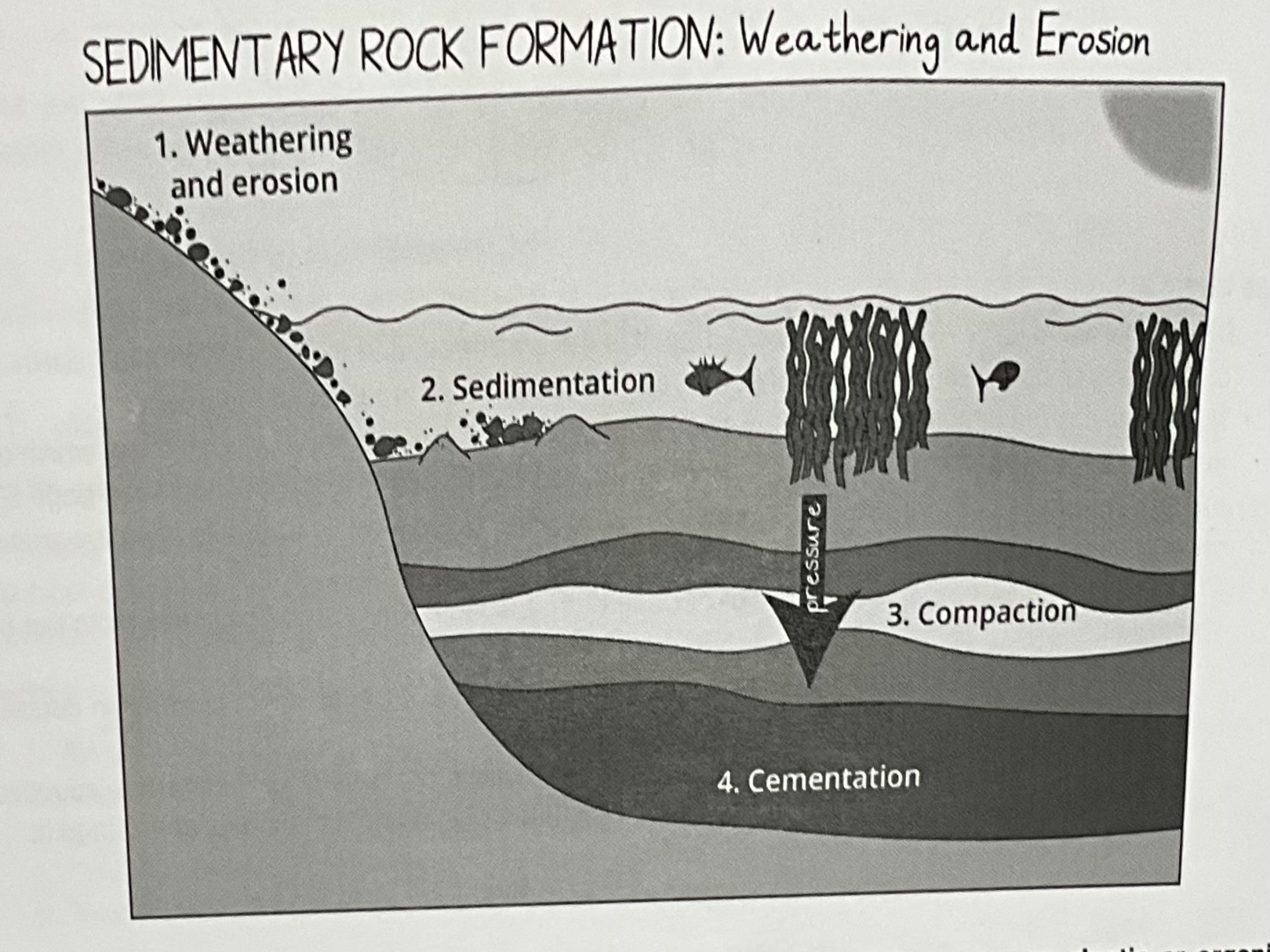
These rocks can either be formed from inorganic or organic materials, known as clastic or organic sedimentary rocks respectively. Inorganic materials are those not living, like plants or animals.
Clastic
Sandstone is probably the most well-known example of an inorganic sedimentary rock formed by this process. Generally, sandstone is made from fine sand particles (usually quartz) and a few other minerals. You can sometimes actually see the layering patterns in sandstone rock.
Organic
Heavily compacted organic material actually form as rocks such as coal and chalk. Coal is made from plant materials whereas chalk is made from the compacted shells and skeletons of past aquatic life-forms.
Precipitation
There are also chemical ways of producing sedimentary rocks. Precipitation occurs when water evaporates, leaving behind minerals or other chemical substances as solid particles on the surface. This can also happen when water temperature or acidity increases, forcing minerals out of solution and solidifying them.
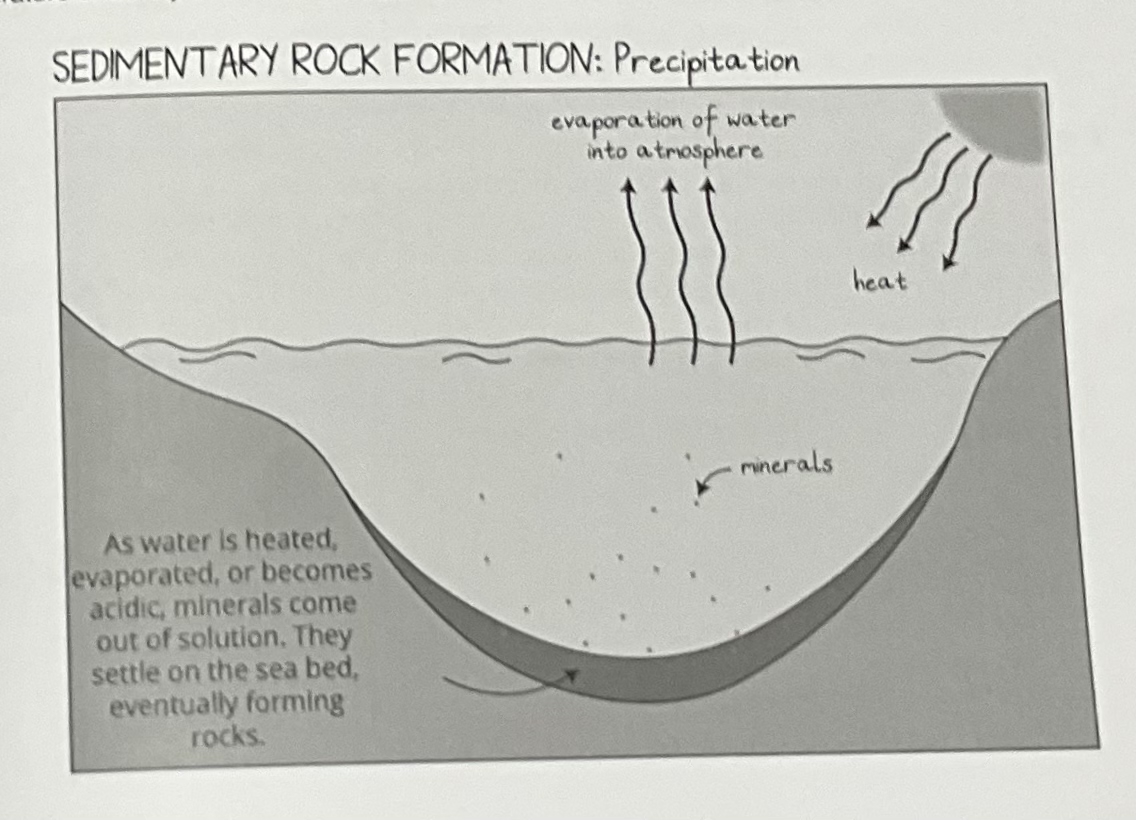
This process usually occurs in dried-up lake beds where minerals, like halite or gypsum, are left as solids on the surface. However, the formation of stalactites and stalagmites in caves happens through precipitation too. Water picks up minerals as it travels through the rock, and when the water evaporates it forms these amazing structures that reach up and drip down from the floors and ceilings of caves. Limestone and rock salt are common examples of sedimentary rocks formed through precipitation.
Igneous Rocks
Ingenious rocks are those that form from magma/lava found beneath the Earth’s surface. Magma is the semi-molten material found in the second layer of the Earth known as the mantle. This liquid is extremely hot (around 1,000 degrees Celsius) and when cooled, it hardens into igneous rock. This can either occur at the surface, around and in volcanoes, or writhing the Earth’s crust. The location and time it takes to cool determines what type of igneous rock it is. There are two major types of igneous rocks:
Extrusive: this type of igneous rock forms on the Earth’s crust, usually around volcanoes where magma spews from the mantle and out into the atmosphere as lava. This type of rock cools very quickly (minutes to months). Because of the quick cooling, these rocks are usually very fine-grained. It takes time to build the kinds of crystal formations we see in other rocks, but because extrusive rocks are cooled so quickly, they don’t have the opportunity to form complex crystal structures. This gives them a smooth and glassy appearance.
Intrusive: this is when igneous rock forms beneath the Earth’s surface, within the crust. The cooling time for intrusive rocks is much slower, taking thousands or millions of years to cool into rock form. This means the grains in this rock type are much larger.

Metamorphic Rocks
This type is formed when other rocks (sedimentary, igneous, or other metamorphic) change into new rocks with unique properties from their ‘parent’ rock. This occurs through extreme heat, pressure, or from contact with a hot liquid (like magma).
The important difference with metamorphic rocks is that they are always still in a solid form, even when heated. (They are never actually heated to the point of becoming molten, as in magma, otherwise they would become igneous rocks.)
Metamorphic rocks are typically formed deep within the Earth’s crust where they undergo intense pressure from the layers above them and are closer to the heat within the mantle. They can also be made at places where the Earth’s crust rubs together and causes friction - this produces heat and break rocks apart due to the force of the two areas sliding against each other.
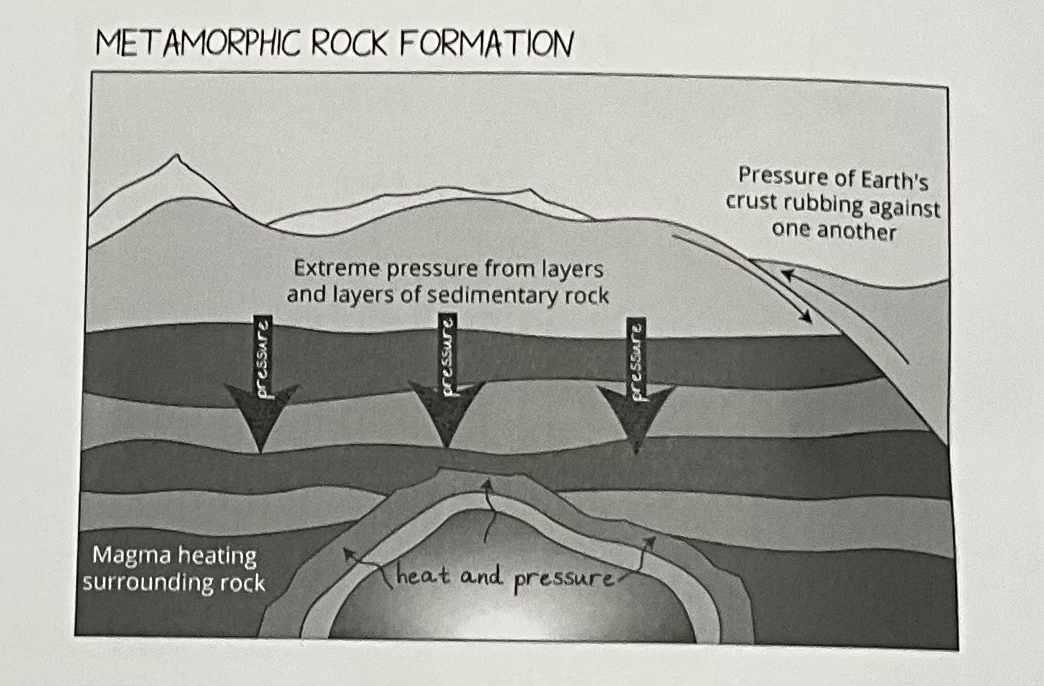
An example of metamorphic rocks such is marble, which is formed under heat and pressure when magma approaches limestone (a sedimentary rock) in the crust.
KEY POINTS:
Sedimentary rocks are made from sediments of other rocks and minerals.
Igneous rocks are made form magma/lava (which you can think of as igniting)/
Metamorphic rocks are made of other rocks that have changed (morphed) through forces happening in the Earth.
Identifying Rocks
There are tests that can be conducted to determine what sort of rock is being looked at. For example, limestone will fizz when reacted with hydrochloric acid. We can also test the hardness of a rock by whether it can be used to scratch glass. Other things we can look out for is the size of the grains (can you see them or not?), whether there are crystals, layering in the rock, the appearance of a glassy surface. And what colour the rock is.
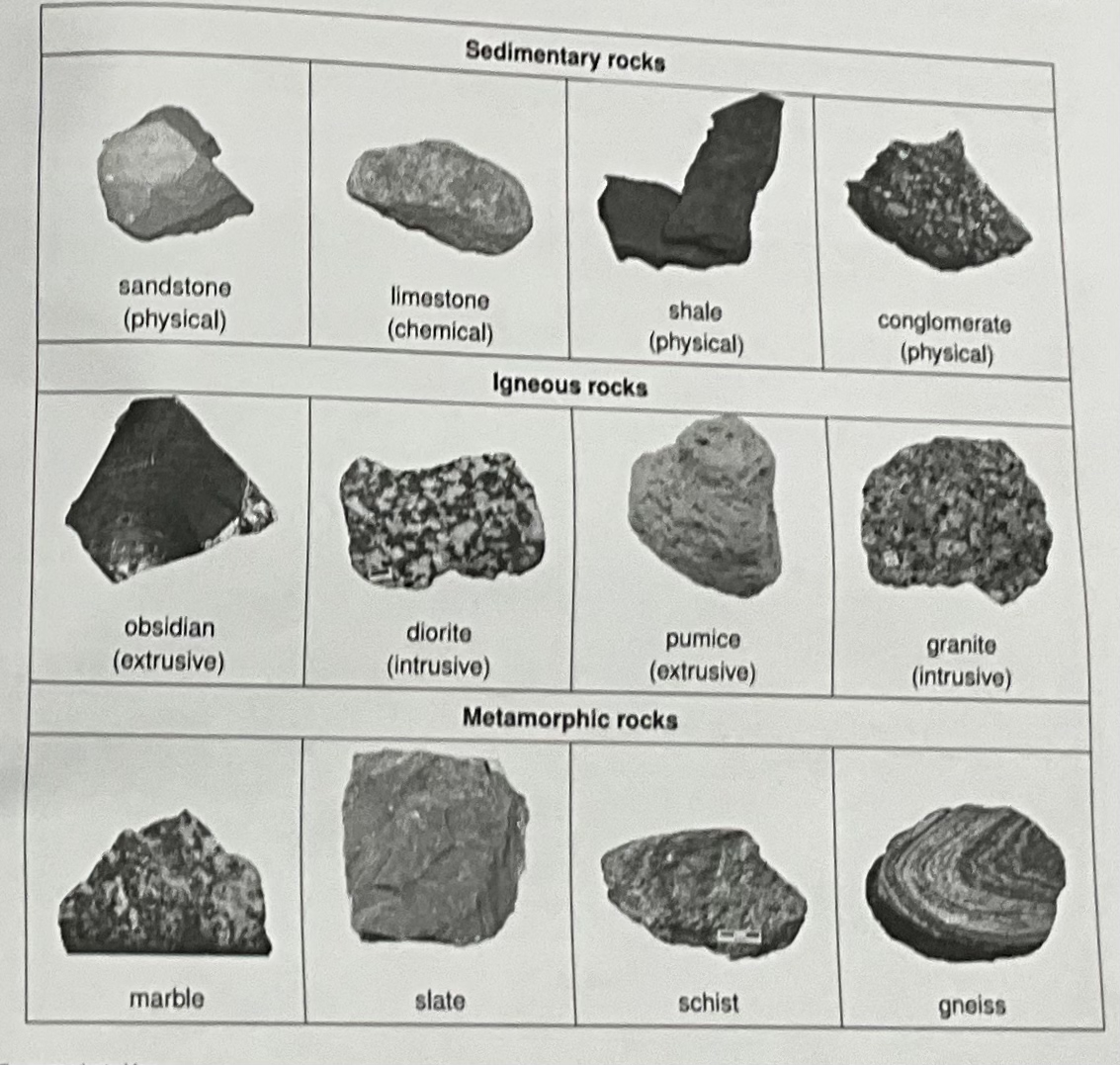
The Rock Cycle
Sedimentary rock will eventually be layered so deep in the crust that it can be compacted and heated into entirely different rocks, known as metamorphic rocks. If those rocks approach too close to the mantle and melt, then they form magma, which when cooled, can turn into igneous rock - either within the Earth’s crust or when it is released from volcanoes. Rocks on the Earth’s surface then weather over thousands of years of contact with natural elements, like wind, and chemicals which then form sediments that collect in ocean beds and on land. These are eventually compacted into sedimentary rock. Then the cycle starts all over again.
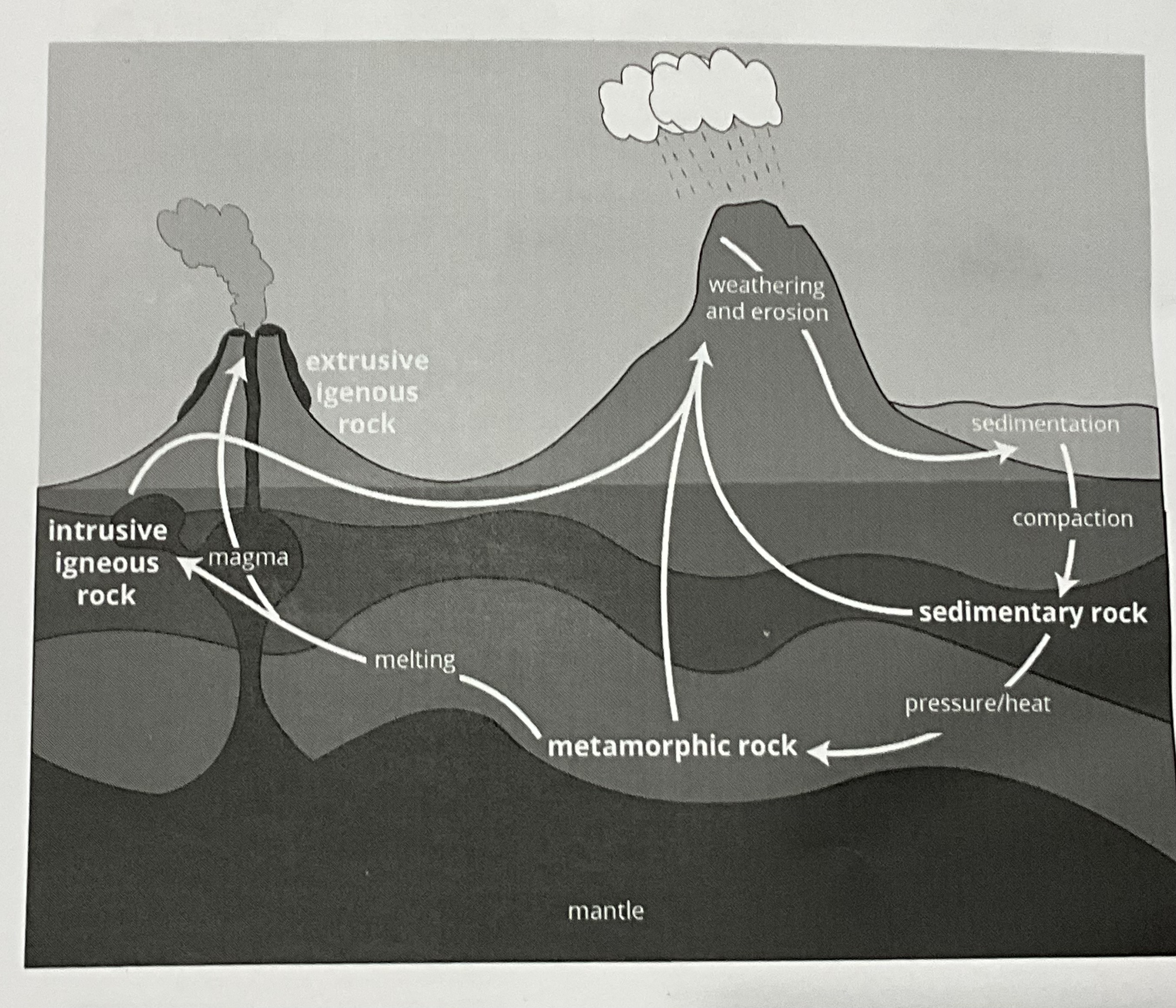
Using Rocks
Minerals and metals has been used as tools for hundreds of thousands of years. For instance, early humans used copper (a metal) to sculpt weapons, which was later replaced by iron. Now, we use metals and minerals found within the Earth in almost every aspect of our society. In computers and phones there is silicon and copper, iron is used in all sorts of infrastructure in the form of steel, and even gold is used every day in jewellery. These metals are not made by us, but found within the Earth in rocks. In this form, these minerals are called ores, which we obtain through mining.
Just like the formation of rock, it can take millions of years for ores to develop, which makes them a resource which is non-renewable. Depending on how rare they are to find and the difficulty of getting them, they can be extremely valuable and expensive. Unfortunately, you can’t reach the valuable ores with a basic shovel - humans use millions of dollars worth of mining equipment to excavate huge swaths of land in order to dig these up. This mining process can be extremely disruptive to communities and ecosystems, especially when large patches of forest or grasslands have to be cleared.
Gemstones are another precious resource found within the Earth. They are precious because of their colour and beauty, like opals or amethyst. Some gemstones are rarer than others and hence cost more. Opal is a precious gemstone famously found in Coober Pedy in South Australia.
Mining and Coordination
Getting precious ores, rocks, and minerals from the Earth is no easy task, and it usually requires the special efforts of scientists from many different fields like geologists, ecologists, engineers, geomorphologists, and chemists. This is because these resources are normally found deep within the Earth or even under the ocean, which means that large amounts of rock need to be removed just to access them.
First the minerals need to be located. Generally special geologists will be tasked with finding and assessing the minerals in a certain region. There are many things that need to be considered in this stage, as we don’t want to disrupt people’s homes or wildlife habitats. We also have to be mindful about land stability and the impacts that might last for many generations. A lot of money is also involved in the initial stages of mine, so the availability of the mineral or ores need to be guaranteed for the mine to go ahead. This is important in assessing whether the costs are worth proceeding with a mining project in order to reap the benefits of precious ores.
Once all these elements have been approved, then the actual mining and extraction can begin. This will generally require the expertise of qualified engineers who oversee the safety of structures, machinery, and processes. This could be an offshore project that requires drilling deep into the sea for gases (which can cause explosions if something goes wrong), or it could be sending people and machines deep underground to extract material. All mining is dangerous, so many experienced individuals would work together to ensure the safety of those working on and around the mine.
The raw materials extracted from the mine will go to some type of chemical plant, like a smelter or refinery, so the products can be turned into a useable form for society. Chemists will then test the purity and quality of the products before they make their way to us.
There are many other roles in the mines and they are a common workplace for industrial scientists, but it needs to be a coordinated effort to undertake large-scale mining projects.
Summary:
Rocks
Rocks are solid and made up of minerals and other matter.
A mineral is something that is made of a single chemical compound and has a distinct crystal structure.
Rock formations occur in the three main layers of the Earth:
Crust: the outermost layer, commonly called the surface of the Earth.
Mantle: the largest layer made up of super-heated, semi-molten rocks.
Core: the extremely hot and dense centre of the Earth.
Rocks can be classified as either sedimentary, igneous, or metamorphic:
Sedimentary rocks are formed from sediments that are compacted over millions of years of pressure from layers on top of them. They can also form in dried up lake beds where minerals are precipitated out of solution.
Igneous rocks are made from magma that comes from the Earth’s mantle. If they form on the surface over a matter of seconds or months they are called extrusive. If they form in the Earth’s crust they are called intrusive and take much longer to form.
Metamorphic rocks are made from other rocks over millions of years of heat and pressure.
When trying to identify rocks look out for grain size, smoothness, glassiness, colouring, etc.
The rock cycle shows how all rocks cycle through the environment in a dynamic process. Sedimentary will eventually become metamorphic rocks or be broken down into sediments. Metamorphic will eventually become melted back into magma to form igneous rocks. Ingenious rock will be broken down by weathering to form sediments and become sedimentary rocks. Remember that nothing in nature is static, even rocks.